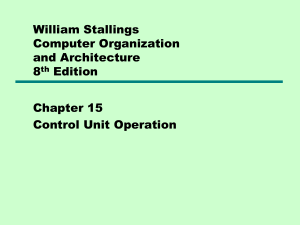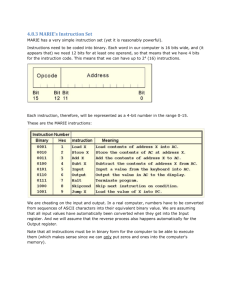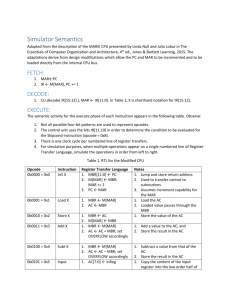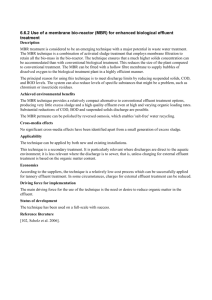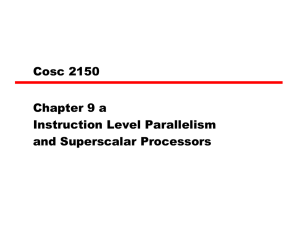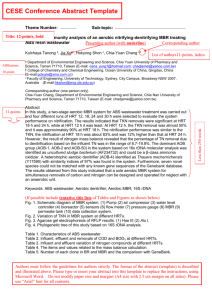micro-operations
advertisement
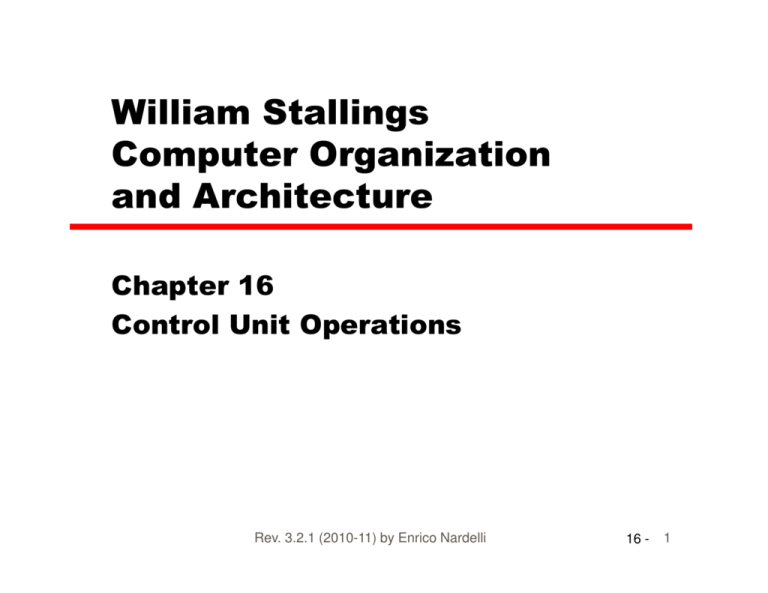
William Stallings Computer Organization and Architecture Chapter 16 Control Unit Operations Rev. 3.2.1 (2010-11) by Enrico Nardelli 16 - 1 Execution of the Instruction Cycle • It has many elementary phases, each executed in a single clock cycle (remember pipelining) • In each phase only very simple operations (called micro-operations) are executed: Move contents between registers (internals, interface with ALU, interface with memory) Activate devices (ALU, memory) • Micro-operations are the CPU atomic operations, hence define its low-level behaviour • A micro-operation is the set of actions (data flows and controls) that can be completed in a single clock cycle Rev. 3.2.1 (2010-11) by Enrico Nardelli 16 - 2 Constituent Elements of Program Execution Rev. 3.2.1 (2010-11) by Enrico Nardelli 16 - 3 Sequence of micro-operations for instruction fetch • t1: MAR <- PC <DF1 > • t2: MBR <- memory <DF2 DF3 DF4 DF5 > PC <- PC +1 <DF7 > • t3: IR <- MBR <DF6 > CPU (each ti is a clock cycle, i.e. an atomic time unit) An alternative organization • t1: MAR <- PC • t2: MBR <- memory • t3: PC <- PC +1 IR <- MBR 2 1 PC 4 MAR 7 Control Unit Memory 4 3 5 6 IR 3 MBR MAR = Memory Address Register MBR = Memory Buffer Register IR = Instruction Register PC = Program Counter Rev. 3.2.1 (2010-11) by Enrico Nardelli Address Bus Data Bus Control Bus 16 - 4 Rules for micro-operation sequencing • Proper precedence must be observed MAR <- PC must precede MBR <- memory • Conflicts must be avoided Must not read & write same register at same time • MBR <- memory & IR <- MBR must not be in same cycle Must not use the same commun. path at the same time • Also: PC <- PC +1 involves addition Depending on the kind of ALU may need additional micro-operations, hence it is better to have it in t2 • Minimization of the number of micro-operations is an algorithmic problem on graphs Rev. 3.2.1 (2010-11) by Enrico Nardelli 16 - 5 Sequence of micro-operations for direct addressing • t1: MAR <- IRaddress <DF1 > • t2: MBR <- memory <DF2 DF3 DF4 DF5 > CPU 3 2 4 MAR Memory 4 Control Unit 1 3 5 IR MBR MAR = Memory Address Register MBR = Memory Buffer Register IR = Instruction Register PC = Program Counter Address Bus Data Bus Rev. 3.2.1 (2010-11) by Enrico Nardelli Control Bus 16 - 6 Sequence of micro-operations for register addressing • t1: Reg. <- IRregister-address <DF1 > CPU 1 Registers Control Unit 1 IR MAR = Memory Address Register MBR = Memory Buffer Register IR = Instruction Register PC = Program Counter Address Bus Rev. 3.2.1 (2010-11) by Enrico Nardelli Data Bus Control Bus 16 - 7 Sequence of micro-operations for register indirect addressing • t1: MAR <- (IRregister-address) <DF1 DF2 > • t2: MBR <- memory <DF3 DF4 DF5 DF6 > CPU 4 3 5 MAR Memory 2 5 1 Registers Control Unit 4 1 6 IR MBR MAR = Memory Address Register MBR = Memory Buffer Register IR = Instruction Register PC = Program Counter Address Bus Data Bus Rev. 3.2.1 (2010-11) by Enrico Nardelli Control Bus 16 - 8 Sequence of micro-operations for indirect addressing • • • • t1 : t2 : t3 : t4 : MAR <MBR <MAR <MBR <- IRaddress memory MBR memory <DF1 <DF2 <DF6 <DF7 > DF3 DF4 DF5 > > DF8 DF9 DF10 > CPU 3-8 2-7 4-9 MAR Memory 4-9 1 6 IR Control Unit MBR MAR = Memory Address Register MBR = Memory Buffer Register IR = Instruction Register PC = Program Counter 3-8 5 - 10 Address Bus Data Bus Control Bus Rev. 3.2.1 (2010-11) by Enrico Nardelli 16 - 9 Sequence of micro-operations for relative addressing • t1: MAR <- IRaddress + PC <DF1 DF2 DF3 DF4 > • t2: MBR <- memory <DF5 DF6 DF7 DF8 > CPU 6 4 PC 2 5 7 MAR Memory 7 ALU 3 Control Unit 6 1 8 IR MAR = Memory Address Register MBR = Memory Buffer Register IR = Instruction Register PC = Program Counter ALU = Arithmetic Logic Unit MBR Address Bus Data Bus Control Bus Rev. 3.2.1 (2010-11) by Enrico Nardelli 16 - 10 Sequence of micro-operations for base and indexed addressing • t1: MAR <- (IRregister-address) + IRaddress <DF1 DF2 DF3 DF4 DF5 > • t2: MBR <- memory <DF6 DF7 DF8 DF9 > CPU 7 5 6 8 MAR ALU Memory 8 2 4 3 Control Unit Registers 7 1 1 9 IR MAR = Memory Address Register MBR = Memory Buffer Register IR = Instruction Register PC = Program Counter ALU = Arithmetic Logic Unit MBR Address Bus Data Bus Rev. 3.2.1 (2010-11) by Enrico Nardelli Control Bus 16 - 11 Sequence of micro-operations for combination of displacement and indirect addressing • Try them yourself ! Rev. 3.2.1 (2010-11) by Enrico Nardelli 16 - 12 Sequence of micro-operations for interrupt handling • t1: MBR <- PC <DF1a > MAR <- Stack-Pointer <DF1b> • t2: memory <- MBR <DF1c DF1d DF1e > Stack-Pointer <- Stack-Pointer + 1 <DF non visualizzati> • t3: MAR <- Interrupt_Address <DF2a > • t4: MBR <- memory <DF2b DF2c DF2d DF2e > CPU • t5: PC <- MBR <DF2f > 1d - 2c 2d 1c - 2b MAR Memory 1b 1e • NOTE: We assume Interrupt_Address is a fixed location known by the Control Unit 2a 1b Registers 1e - 2d Control Unit 1d - 2c 2e 2f MBR PC 1a 1c MAR = Memory Address Register Rev.MBR 3.2.1 (2010-11) by Enrico Nardelli Address = Memory Buffer Register IR = Instruction Register PC = Program Counter Bus Data Bus Control Bus 16 - 13 Micro-operation sequencing for the execution phase (1) • Different for each instruction • SUM X – sum the contents of memory cell X and Accumulator and store back the result in cell X Assuming that after the operand fetch phase content of cell at address X is in MBR : t1 : ALU <- AC + MBR t2 : AC <- ALU t3 : MBR <- AC; MAR <- IRaddress t4 : memory <- MBR Rev. 3.2.1 (2010-11) by Enrico Nardelli 16 - 14 Micro-operation sequencing for the execution phase (2) • ISZ X - increment memory cell X and if it’s zero skip the next instruction Assuming that content of cell at address X is in MBR after the operand fetch phase: t1 : ALU <- MBR + 1 t2 : MBR <- ALU t3 : memory <- MBR IF MBR == 0 THEN PC <- PC + 1 • Note: IF-THEN is a single micro-operation Rev. 3.2.1 (2010-11) by Enrico Nardelli 16 - 15 Micro-operation sequencing for the execution phase (3) • CALL X - Save in stack the return address and jump to address X t1 : t2 : t3 : MBR <- PC MAR <- SP memory <- MBR ALU <- SP + 1 PC <- IRaddress SP <- ALU Rev. 3.2.1 (2010-11) by Enrico Nardelli 16 - 16 A simplified flow diagram for the execution of instruction cycle ICC = Instruction Cycle Code 11 (Interrupt) ICC? 01 (Indirect Addressing) 10 (Execution) Execute interrupt handling micro-ops 00 (Fetch) Execute indirect addressing micro-ops Opcode? Execute micro-ops for the given opcode ICC = 00 No ICC = 10 Interrupt enabled? ICC = 11 Execute instruction fetch micro-ops Indirect addressing? Execute direct addressing micro-ops ICC = 00 Rev. 3.2.1 (2010-11) by Enrico Nardelli Yes ICC = 01 ICC = 10 16 - 17 Functions of Control Unit • Sequencing Causing the CPU to step through a series of microoperations • Execution Causing the execution of each micro-op • ALL THESE ACTIONS are performed by means of Control Signals Rev. 3.2.1 (2010-11) by Enrico Nardelli 16 - 18 A simplified data flow diagram of a Control Unit Instruction Register … Flags Control Unit Control Signals Control Bus Signals internal to CPU Clock Control Signals Rev. 3.2.1 (2010-11) by Enrico Nardelli 16 - 19 Control Unit’s Input Signals • Clock One micro-op (or set of parallel ops) per clock cycle Different signals are needed for different steps • Instruction register Op-code for current instruction Determines which micro-instructions are performed • Flags State of CPU Results of previous operations • Control Bus Interrupts Acknowledgments Rev. 3.2.1 (2010-11) by Enrico Nardelli 16 - 20 Control Unit’s Output Signals • To other CPU components For data movement To activate specific functions • To the Control Bus To control memory To control I/O modules • Output signals from the control unit (i.e., Control Signals) make all micro-operations happen Rev. 3.2.1 (2010-11) by Enrico Nardelli 16 - 21 Data Bus Simplified schema of a CPU: connections and control gates C5 C12 C11 M B R C15 C1 C3 C4 C8 C10 PC C13 IR Address Bus C6 C2 C0 C16 C14 Flags Cx Control Gate x: The flow of data is enabled when the Control Signal x is enabled C7 C9 Decod. … M A R AC Control Unit ALU … Control signals Cx Clock … Control signals Cx Rev. 3.2.1 (2010-11) by Enrico Nardelli 16 - 22 Example of Control Signal Sequence – Instruction Fetch (1) • t1: MAR <- PC Control unit (CU) activates signal C2 to open gate from PC to MAR • t2-1: MBR <- memory CU activates C0 to open gate from MAR to address bus CU activates the memory read control signal (CR not shown) to the memory CU activates C5 to open gate from data bus to MBR Rev. 3.2.1 (2010-11) by Enrico Nardelli 16 - 23 Example of Control Signal Sequence – Instruction Fetch (2) • t2-2: PC <- PC +1 In the considered CPU’s internal schema, ALU’s output is not directly connected to PC but only to AC. Therefore this micro-operation has to be split in two subsequent time units. What would happen if we had ALU’s output directly connected to PC? • t3: IR <- MBR CU activates C4 to open gate from MBR to IR Rev. 3.2.1 (2010-11) by Enrico Nardelli 16 - 24 Example of Control Signal Sequence – Instruction Fetch (3) • Splitting the increment of Program Counter ALU is a fast combinational circuit whose inputs and output are not buffered ALU has a specific control signal CA for unitary increment without a second input • t2-2: PC <- PC +1 t2-2-1: ALU <- PC CU activates C14 from PC to ALU increment ALU CU act. control signal CA (not shown) for ALU AC <- ALU CU activates C9 from ALU to PC t2-2-2: PC <- AC CU activates C15 from AC to PC Rev. 3.2.1 (2010-11) by Enrico Nardelli 16 - 25 Example of Control Signal Sequence – Instruction Fetch (4) • Optimization t2-1 and t2-2-1 can be executed together t2-2-2 and t3 can be executer together • New organization t1 : t2 : t3 : MAR <- PC MBR <- memory ALU <- PC increment ALU AC <- ALU PC <- AC IR <- MBR C2 C0 C14 CA C9 C15 C4 Rev. 3.2.1 (2010-11) by Enrico Nardelli CR C5 16 - 26 Example of Control Signal Sequence - Direct Addressing • Direct addressing is executed right after instruction fetch in our simplified flow diagram for the execution of an instruction cycle. Hence: • t4: MAR <- IRaddress CU activates C16 to open gate from IR to MAR • t5: MBR <- memory CU act. C0 to open gate from MAR to address bus CU act. the memory read control signal CR CU act. C5 to open gate from data bus to MBR Rev. 3.2.1 (2010-11) by Enrico Nardelli 16 - 27 Example of Control Signal Sequence - Indirect Addressing • t1: MAR <- IRaddress CU activates C16 to open gate from IR to MAR • t2: MBR <- memory CU act. C0 to open gate from MAR to address bus CU act. the memory read control signal CR CU act. C5 to open gate from data bus to MBR • t3: MAR <- MBR CU activates C8 to open gate from MBR to MAR • t4: MBR <- memory CU activates C0, CR and C5 as above Rev. 3.2.1 (2010-11) by Enrico Nardelli 16 - 28 Example of Control Signal Sequence – Execution: SUM • t1 : ALU <- AC + MBR CU activates C6 to open gate from MBR to ALU CU activates C7 to open gate from AC to ALU CU activates for the ALU the sum control signal CS • t2 : AC <- ALU CU activates C9 to open gate from ALU to AC • t3 : MBR <- AC; MAR <- IRaddress CU activates C11 to open gate from AC to MBR CU activates C16 to open gate from IR to MAR • t4 : memory <- MBR CU activates C0 to open gate from MAR to address bus CU activates C12 to open gate from MBR to data bus CU activates the memory write control signal CW • NOTE: Now ALU’s output needs to be “buffered”: this means that its output lines are not directly coming from the internal combinational circuits but from a registry (buffer) that receives combinational circuits outputs and store them for a subsequent reading Rev. 3.2.1 (2010-11) by Enrico Nardelli 16 - 29 Limitations • The simplified internal schema of a CPU does not show registers, hence we cannot show Register addressing Register indirect addressing Base addressing Indexed addressing Combination of displacement and indirect addressing Try adding to the simplified schema one or more of the above addressing modalities and derive the required micro-operations! Rev. 3.2.1 (2010-11) by Enrico Nardelli 16 - 30 Internal Organization of CPU • Usually a single internal bus less complex then having direct data paths between registers and ALU • Control gates control movement of data onto and off the internal bus • Control signals control also data transfer to and from external systems bus • Temporary registers (i.e., buffers) in input to ALU are now needed for proper operation of ALU • After Appendix B try yourself deriving the control signal sequences for a single internal bus CPU! Rev. 3.2.1 (2010-11) by Enrico Nardelli 16 - 31 How to implement the instruction cycle in hardware? ICC = Instruction Cycle Code 11 (Interrupt) ICC? 01 (Indirect Addressing) 10 (Execution) Execute interrupt handling micro-ops 00 (Fetch) Execute indirect addressing micro-ops Opcode? Execute micro-ops for the given opcode ICC = 00 No ICC = 10 Interrupt enabled? ICC = 11 Execute instruction fetch micro-ops Indirect addressing? Execute direct addressing micro-ops ICC = 00 Rev. 3.2.1 (2010-11) by Enrico Nardelli Yes ICC = 01 ICC = 10 16 - 32 Hardwired Implementation (1) • Consider the control unit as a combinational circuit Outputs of the circuit are the control signals Inputs of the circuit are: • ICC register bits (note that ICC is not visualized in the CPU’s simplified internal schema) • Status flags, including interrupt-enable/disable (T) • Direct/indirect address bit (D) • Decoded opcodes (OCn) • Clocks (tn) For each configuration of inputs produce a proper output That is, the activation of a given control signal Cn has to happen when (condition A is true) OR (condition B is true) OR … Rev. 3.2.1 (2010-11) by Enrico Nardelli 16 - 33 Data flow diagram of the Control Unit for the hardwired implement. of the CPU’s simplified schema Instruction Register Decoder ICC D OC1 … OCm t1 … Clock clocks for mOPs … Flags Control Signals internal to CPU Control Unit Control Bus T External Control Signals tn Rev. 3.2.1 (2010-11) by Enrico Nardelli 16 - 34 Hardwired Implementation (2) • Control signals P and Q code ICC: then fetch (instruction + direct addr.) is coded by P’Q’, indirect by P’Q, execute by PQ’, and interrupt by PQ • Direct addressing is coded by D (D’ = indirect) • Decoded opcodes provide are further control signals • Interrupt enable is coded by T (T’ = interrupt disabled) • Each clock tn is a control signal • Boolean expression activating C5 in the simplified schema of a CPU (see slides 26, 27, 28 and 13): C5 = P’Q’(t2+ Dt5) + P’Q(t2+ t4) + PQ’B + PQ t4 where B is the boolean expression representing, for all opcodes activating C5, all micro-operations actually activating it example: if C5 is activated only by opcode 3 during t2 and t4 and by opcode 7 during t3 and t4 then B is: OC3(t2+t4)+OC7(t3+t4) Rev. 3.2.1 (2010-11) by Enrico Nardelli 16 - 35 Hardwired Implementation (3) • Updating ICC: Assume no micro-procedure requires more than 5 time units Update P and Q using clock t6, current values of P and Q, interrupt enabled flag (T), direct address signal (D) At the end of direct addressing branch of fetch phase (00) • P = P’Q’ t6 D Q’ = P’Q’ t6 D At the end of indirect addressing branch of fetch phase (00) • P’ = P’Q’ t6 D’ Q = P’Q’ t6 D’ At the end of indirect addressing phase (01) • P = P’Q t6 Q’ = P’Q t6 At the end of interrupt enabled branch of execution phase (10) • P = PQ’ t6 T Q = PQ’ t6 T At the end of interrupt disabled branch of execution phase (10) • P’ = PQ’ t6 T’ Q’ = PQ’ t6 T’ At the end of interrupt phase (11) • P’ = PQ t6 Q’ = PQ t6 Rev. 3.2.1 (2010-11) by Enrico Nardelli 16 - 36 Hardwired Implementation (4) • Do we forget anything? Discarding t6 (present in all terms) we have P = P’Q’ D + P’Q + PQ’ T Q = P’Q’ D’ + PQ’ T and P P’Q’ P’Q PQ PQ’ 00 01 11 10 and P’ = P’Q’ D’ + PQ’ T’ + PQ Q’ = P’Q’ D + P’Q + PQ’ T’ + PQ Q P’Q’ P’Q PQ PQ’ 00 01 11 10 T’D’ 00 0 1 0 0 T’D’ 00 1 0 0 0 T’D 01 1 1 0 0 T’D 01 0 0 0 0 TD 11 1 1 0 1 TD 11 0 0 0 1 TD’ 10 0 1 0 1 TD’ 10 1 0 0 1 Rev. 3.2.1 (2010-11) by Enrico Nardelli 16 - 37 Problems with the Hardwired Implementation • • • • Complex sequencing & micro-operation logic Difficult to design and test Inflexible design Difficult to add new instruction Rev. 3.2.1 (2010-11) by Enrico Nardelli 16 - 38
